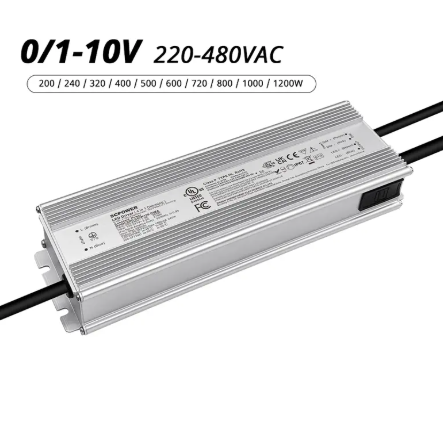LED lighting has transformed how we illuminate homes, offices, and industrial facilities. Yet, despite their promise of long life and efficiency, many LED systems fail prematurely — and most of these failures trace back to driver issues. Flickering lights, sudden shutdowns, and uneven brightness can lead to costly replacements and frustrated users. In this comprehensive guide, we’ll dive into LED driver power, covering its importance, the types available, how to choose the right driver, and practical troubleshooting tips. Whether you’re upgrading your home lighting or managing a large commercial project, this guide will help you avoid common mistakes and keep your LEDs running smoothly.
What is an LED Driver?
Definition of an LED Driver
An LED driver is an essential electrical device that regulates the voltage and current supplied to LED lights. Unlike traditional incandescent bulbs, which can operate directly from a standard power supply, LEDs need precise power regulation to function optimally. Because voltage and current fluctuations can reduce LED performance and lifespan, the LED driver keeps the power stable and within the required specifications, maximizing efficiency and longevity.
Why LED Drivers Are Important
LED drivers enhance the performance and reliability of LED lighting systems. They prevent overheating, flickering, and early failure by supplying consistent, stable power. This stable supply ensures uniform light output and improves energy efficiency. By actively regulating power, LED drivers allow LEDs to operate at their optimal levels, reducing energy consumption and lowering operating costs. In short, an LED driver serves as the backbone of any LED lighting system, helping lights perform at their best while minimizing maintenance and replacements.
How Does an LED Driver Work?
Voltage Conversion
One of the primary functions of an LED driver is to convert the incoming alternating current (AC) voltage to a direct current (DC) voltage suitable for LEDs. Typically, LED drivers take an input voltage from 120V to 277V AC and convert it to a lower DC voltage, such as 12V or 24V. This voltage conversion ensures that LEDs receive a stable DC voltage for efficient operation. The driver also protects LEDs from voltage spikes and fluctuations, providing a reliable power supply. By maintaining a consistent voltage, the driver prevents LED damage and extends their lifespan.
Preventing Common LED Issues
LED drivers play a vital role in preventing flickering, dimming, and overheating in LED lighting. Voltage fluctuations or inadequate power supply can cause flickering, which disrupts both LED performance and the lighting experience. By supplying regulated, stable power, LED drivers eliminate flickering and ensure consistent light output. Overheating can shorten LED lifespan, but LED drivers maintain optimal temperatures by controlling power and preventing excessive heat buildup, allowing LEDs to operate safely and efficiently for longer periods.

Types of LED Drivers
Constant Current LED Drivers
Constant current LED drivers deliver a steady and consistent current to LEDs, regardless of changes in the load or voltage. They work best for high-power LED arrays in industrial or commercial settings, where maintaining a constant current ensures optimal performance. In large-scale applications, such as warehouse lighting or outdoor floodlights, constant current drivers make sure each LED receives the same amount of current, producing uniform brightness and efficient operation. By actively regulating current, these drivers prevent thermal runaway, a common issue in high-power LED setups. For industrial projects, choosing the best LED driver for high-power LEDs ensures reliability and long lifespan.
Constant Voltage LED Drivers
Constant voltage LED drivers maintain a fixed output voltage while letting the current adjust according to the load. They work best for LED strips and decorative lighting, where voltage requirements remain constant. For example, accent lighting, under-cabinet LED strips, or signage require the best LED driver for LED strips to keep brightness consistent along the entire length. Single-color LED applications also benefit from constant voltage drivers, as they focus on stabilizing voltage rather than regulating current.
Dimmable vs Non-Dimmable LED Drivers
Another key distinction among LED drivers lies in dimming capabilities. Dimmable LED drivers allow adjustable brightness levels, giving users greater control over the lighting environment. This feature proves useful in applications such as mood lighting, conference rooms, or home theaters, where varying brightness creates different atmospheres. External dimmers, such as TRIAC dimmers, 1–10V dimmers, or trailing-edge dimmers, work with the LED driver to adjust power supply and control LED brightness. In addition to improving user experience, dimmable drivers help save energy by letting users reduce brightness when full illumination is unnecessary. Selecting the best LED driver for dimmable applications ensures smooth brightness control and energy efficiency.
LED Driver Specifications and Key Features
Output Voltage and Current
When selecting an LED driver, you must match the output voltage and current to your LED system’s specific requirements. The driver should deliver voltage and current that meet the LED specifications to ensure optimal performance and long lifespan. For instance, if your LEDs need 12V DC and 1A, choose a driver that supplies exactly these values. Supplying mismatched voltage or current can reduce efficiency, cause flickering, or even damage the LEDs. Understanding your system’s power needs helps you choose the right driver and avoid costly issues.
Power Factor (PF)
Power factor (PF) measures how efficiently the driver converts incoming power into usable power for the LEDs. Drivers with a high power factor (typically above 0.9) deliver power more efficiently, reduce energy loss, and actively lower overall energy consumption. By selecting a high PF driver, you not only save on operating costs but also create a more sustainable and environmentally friendly lighting solution.
Ingress Protection (IP Rating)
IP ratings classify how well a driver’s enclosure protects against dust, water, and other environmental hazards. When installing LEDs outdoors or in damp areas, choose a driver with an appropriate IP rating. For example, an IP65-rated driver resists dust ingress and low-pressure water jets, making it ideal for outdoor applications. In contrast, an IP20-rated driver suits indoor installations and protects against solid objects and light dust. Selecting the correct IP-rated driver ensures reliable operation under specific environmental conditions.
Emergency LED Drivers
For critical applications like emergency lighting, choose LED drivers with built-in battery backup. These drivers supply reliable power during outages, keeping emergency lights functional and compliant with building and safety codes. By using emergency LED drivers, you ensure that critical areas remain illuminated even when the main power fails, safeguarding occupants and meeting regulatory requirements.
Common Applications of LED Drivers
LED drivers are used in a wide range of applications, from residential lighting to large-scale commercial and industrial installations. Here are some common applications where LED drivers play a crucial role:
Residential Lighting
In residential settings, LED drivers are used to power various lighting fixtures, such as recessed lights, under-cabinet lighting, and decorative LED strips. They ensure that the LEDs provide consistent and efficient illumination while enhancing the overall lighting experience.
Commercial and Industrial Lighting
Commercial and industrial facilities, such as warehouses, retail stores, and offices, rely on LED drivers to power high-bay lights, linear fixtures, and other large-scale lighting systems. These drivers help maintain optimal lighting conditions, reduce energy consumption, and minimize maintenance efforts.
Outdoor and Decorative Lighting
For outdoor and decorative lighting applications, such as streetlights, landscape lighting, and signage, LED drivers with suitable IP ratings are essential. They protect the drivers from environmental factors and ensure reliable operation in various weather conditions.
Emergency Lighting Systems
In emergency lighting systems, LED drivers with battery backup capabilities are used to provide power during power outages. These drivers ensure that critical areas, such as exit signs and emergency lights, remain illuminated, complying with building and safety codes.

Frequently Asked Questions About LED Drivers
Can I use an LED without a driver?
While some low-power LEDs can operate directly from a power supply, most high-power LEDs and LED arrays require a driver to regulate the voltage and current. Using an LED without a driver can lead to reduced performance, flickering, and premature failure due to voltage and current fluctuations.
How do I know if I need constant current or constant voltage?
The type of driver you need depends on the specifications of your LED system. If your LEDs require a constant current supply to maintain consistent brightness and performance, a constant current driver is necessary. On the other hand, if your LEDs operate on a fixed voltage, such as LED strips, a constant voltage driver is more appropriate. Always refer to the manufacturer’s specifications to determine the correct type of driver for your application.
Are all LED drivers dimmable?
No, not all LED drivers are dimmable. Dimmable LED drivers are specifically designed to work with external dimmers to adjust the brightness of the LEDs. If you require dimming capabilities, it is important to choose a driver that is compatible with the dimming method you plan to use, such as TRIAC, 1-10V, or trailing edge dimming.
How long do LED drivers last?
The lifespan of an LED driver can vary depending on several factors, including its quality, operating conditions, and proper installation. High-quality drivers with good efficiency and durability can last for many years, often exceeding the lifespan of the LEDs themselves. However, factors such as excessive heat, voltage fluctuations, and improper installation can reduce the driver’s lifespan. To maximize the longevity of your LED driver, it is important to select a high-quality product, install it correctly, and ensure that it operates within its specified conditions.
Can LEDs work directly on AC power?
Most LEDs are designed to operate on direct current (DC) and require a driver to convert the incoming alternating current (AC) power to DC. Operating LEDs directly on AC power can cause flickering, reduced performance, and potential damage due to voltage and current fluctuations. However, there are some specialized LEDs designed to operate directly on AC power, but these are less common and typically have specific applications.
Conclusion
LED driver power is a critical factor in ensuring the performance, efficiency, and longevity of LED lighting systems. By understanding the importance of LED drivers, the different types available, and how to select the right one for your application, you can maximize the benefits of LED lighting. Whether you are upgrading your home lighting or implementing a large-scale commercial project, choosing the correct LED driver is essential for a reliable and efficient lighting solution.
At Zhuhai Shengchang Electronics, we've powered 12,000+ installations from Chicago warehouses to Miami hotels. Try our Driver Match Tool to find your perfect fit in 60 seconds.
















